Mentolio
Active Member
This is going to be a "initial impression review" of the Hobbywing EZ Run MAX10SCT 120amp ESC and its accompanying model 3660, 3300kv motor.
Some background: my brushless experience is limited to inexpensive (ok, cheap!) Turnigy components and systems from Hobby King (which ARE cheap and -knock wood- have worked pretty well for me). I also have a used Traxxas VXL system. The stuff impressed me compared to brushed systems, but it didn't make me want to spend the money upgrading my whole collection. So I was looking at another Turnigy (120 amp ESC and a 2200kv motor) system to replace my stock stuff in the Granite, or put in the EMaxx if it didn't work out. The specs of that system scared me a bit (ESC seemed a little weak for the motor). I also looked at Hobby King branded stuff, which spec'd better and cost a little bit more (I may go that route for my EMaxx). I remembered Hobbywing being mentioned several times, and so went to the Hobbywing North America sight, and checked out their stuff.
My goal was to buy a system to replace the stock Mega Brushed system in my Granite 4X4. I'm not necessarily looking for more power, nor do I wish to run 3, 4, or 6s. I find the brushed system running 2S to be plenty fast, and would probably leave it alone until it dies but for its one glaring problem: heat/thermal shutdown. Mine won't run through a whole 4amp battery without shutting down due to heat. Options: run a higher turn brushed motor, but loose the power I had grown accustomed to (nah). Add a fan/fans to the existing system (nope). Find a different brushed ESC (XL5 or my CCSW3 might have worked) and hope that helps (meh!). Or go brushless. Ding-ding-ding!
Some guys use 1/8th systems and run 4-6S, which is cool, but I'd like to keep breakage to a minimum. Other guys are running lower amp systems with higher KV motors, but I'm worried about heat (I bash in grass all the time). I did try my Turnigy 80amp 3520kv 4pole system, but it did get a little hotter than I was willing to let slide, this with the 14tooth pinion (no gearing-up for that system in this truck).
Ok, sorry...on to the goods! The Hobbywing system set me back just under 150 bucks, including the LCD program box. It's the Max10 SCT 120 amp ESC with 3660 3300kv motor. Upon opening the box, I find this:
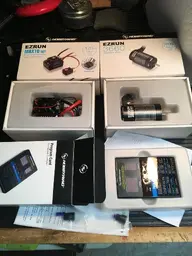
Anyone remember buying their first apple product? The thing I (strangely) remember most is the packaging. It was sooooo nice. It gave my first iPhone such a hi-end appearance! Old moldy potato chips become a treasure in a really nice box.
The second thing I noticed was that the motor came with a 25 tooth pinion, in 48p?!? The website didn't say anything about that...bonus! And the rest of the stuff: a spare cooling fan, which I suspect could be mounted on either the ESC (if the original breaks) or the motor with the right bracket. A mounting plate THAT FITS MY GRANITE IN THE STOCK POSITION! That was also a really pleasant surprise. There is double sided tape, extra screws, a program box connector, two zip ties, an extra (auxiliary, not replacement) capacitor pack, and heat shrink tubing! The program box came with another connector lead, and stickers to place on the face of it if you are using it to program aircraft electronics. This set came with a lot of stuff!
I immediately plugged the system in to the receiver and a battery, programmed it for my radio (using easy to understand instructions), and tested. Very smooth, and very easy to install. I had to expand the upper motor mounting hole for the 15 tooth pinion to get my new Hot Racing 16 tooth 5mm, 48p pinion to mesh properly. It all took about 10 minutes.
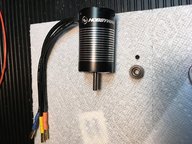
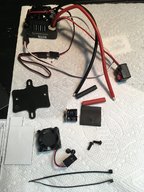
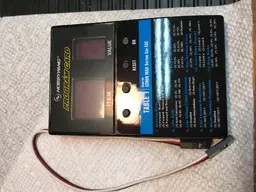
Next, the ESC is retained on the mounting plate using screws, which is preferable to using the supplied double sided tape (in my mind). The plate has two mounting tabs that are slotted, and it fits right where the stocker sat before it. Again, it took very little time to do. It took me longer to feed the ESC connector through the silicone seal properly than it did to get the rest of the ESC mounting done. The motor leads plug into the ESC, and another smaller lead plugs into the motor (for temperature monitoring, not a sensor. This system is sensorless).
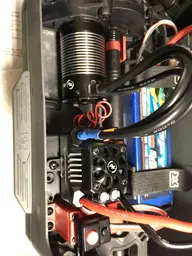
Then I used the program box to check that all the "adjustments" were where they should be. The only thing I really messed with was setting the battery "sensing" from "auto" to 2S, and to set the punch all the way down (nice and soft to start). I then tightened the slipper to full tight, added one of my 4000mah 2S 40C batteries, and took it out for a spin. I was concerned that it would be kinda slow, as my motor is lower kv than what most guys are using (with 1/10 scale systems, anyway), and I'm only running a 16 tooth pinion. Lemme tell ya, it's a few mph FASTER than it was with the stock system AND a 17 tooth pinion! Unexpected...it's just a tiny bit slower than I remember it being with the 3520kv Turnigy system, and a 14t pinion. WIN! Also of note, even tho the punch control is dialed all the way "soft," it'll still spin the wheels on concrete without breaking the slipper loose (from a stop, smashing the throttle...weird). I did experiment a bit with that, and found that slipper just needs to be pretty tight. Not on "lock", but damned near. I mostly heard it at high speed, not so much low speed, when I loosened it up.
As of this writing I've only run it for about ten minutes, and it it was at high speed and in the grass. Gear mesh is just as noisy as it ever was (my other 48p systems aren't this loud?!?). ESC temp never exceeded 100 degrees F, and the motor never got over 125. Granted, that's not exactly a "torture test," but it does show a lot of promise! As I run it more, I will also experiment with the punch adjustment, and start dialing that up. I suspect with just a little more "punch," this lil'bugger may even start to wheelie!
Ok, it's wordy...sorry for that! To conclude my INITIAL feelings about this system, I couldn't be happier! Easy to install, program, and use...didn't cost a small fortune...made in China-yes-but still very classy so far! More to come as I run it and punish...I meant "further test" it. If you got this far, hope it helps, and thanks for reading!
Some background: my brushless experience is limited to inexpensive (ok, cheap!) Turnigy components and systems from Hobby King (which ARE cheap and -knock wood- have worked pretty well for me). I also have a used Traxxas VXL system. The stuff impressed me compared to brushed systems, but it didn't make me want to spend the money upgrading my whole collection. So I was looking at another Turnigy (120 amp ESC and a 2200kv motor) system to replace my stock stuff in the Granite, or put in the EMaxx if it didn't work out. The specs of that system scared me a bit (ESC seemed a little weak for the motor). I also looked at Hobby King branded stuff, which spec'd better and cost a little bit more (I may go that route for my EMaxx). I remembered Hobbywing being mentioned several times, and so went to the Hobbywing North America sight, and checked out their stuff.
My goal was to buy a system to replace the stock Mega Brushed system in my Granite 4X4. I'm not necessarily looking for more power, nor do I wish to run 3, 4, or 6s. I find the brushed system running 2S to be plenty fast, and would probably leave it alone until it dies but for its one glaring problem: heat/thermal shutdown. Mine won't run through a whole 4amp battery without shutting down due to heat. Options: run a higher turn brushed motor, but loose the power I had grown accustomed to (nah). Add a fan/fans to the existing system (nope). Find a different brushed ESC (XL5 or my CCSW3 might have worked) and hope that helps (meh!). Or go brushless. Ding-ding-ding!
Some guys use 1/8th systems and run 4-6S, which is cool, but I'd like to keep breakage to a minimum. Other guys are running lower amp systems with higher KV motors, but I'm worried about heat (I bash in grass all the time). I did try my Turnigy 80amp 3520kv 4pole system, but it did get a little hotter than I was willing to let slide, this with the 14tooth pinion (no gearing-up for that system in this truck).
Ok, sorry...on to the goods! The Hobbywing system set me back just under 150 bucks, including the LCD program box. It's the Max10 SCT 120 amp ESC with 3660 3300kv motor. Upon opening the box, I find this:

Anyone remember buying their first apple product? The thing I (strangely) remember most is the packaging. It was sooooo nice. It gave my first iPhone such a hi-end appearance! Old moldy potato chips become a treasure in a really nice box.
The second thing I noticed was that the motor came with a 25 tooth pinion, in 48p?!? The website didn't say anything about that...bonus! And the rest of the stuff: a spare cooling fan, which I suspect could be mounted on either the ESC (if the original breaks) or the motor with the right bracket. A mounting plate THAT FITS MY GRANITE IN THE STOCK POSITION! That was also a really pleasant surprise. There is double sided tape, extra screws, a program box connector, two zip ties, an extra (auxiliary, not replacement) capacitor pack, and heat shrink tubing! The program box came with another connector lead, and stickers to place on the face of it if you are using it to program aircraft electronics. This set came with a lot of stuff!
I immediately plugged the system in to the receiver and a battery, programmed it for my radio (using easy to understand instructions), and tested. Very smooth, and very easy to install. I had to expand the upper motor mounting hole for the 15 tooth pinion to get my new Hot Racing 16 tooth 5mm, 48p pinion to mesh properly. It all took about 10 minutes.



Next, the ESC is retained on the mounting plate using screws, which is preferable to using the supplied double sided tape (in my mind). The plate has two mounting tabs that are slotted, and it fits right where the stocker sat before it. Again, it took very little time to do. It took me longer to feed the ESC connector through the silicone seal properly than it did to get the rest of the ESC mounting done. The motor leads plug into the ESC, and another smaller lead plugs into the motor (for temperature monitoring, not a sensor. This system is sensorless).

Then I used the program box to check that all the "adjustments" were where they should be. The only thing I really messed with was setting the battery "sensing" from "auto" to 2S, and to set the punch all the way down (nice and soft to start). I then tightened the slipper to full tight, added one of my 4000mah 2S 40C batteries, and took it out for a spin. I was concerned that it would be kinda slow, as my motor is lower kv than what most guys are using (with 1/10 scale systems, anyway), and I'm only running a 16 tooth pinion. Lemme tell ya, it's a few mph FASTER than it was with the stock system AND a 17 tooth pinion! Unexpected...it's just a tiny bit slower than I remember it being with the 3520kv Turnigy system, and a 14t pinion. WIN! Also of note, even tho the punch control is dialed all the way "soft," it'll still spin the wheels on concrete without breaking the slipper loose (from a stop, smashing the throttle...weird). I did experiment a bit with that, and found that slipper just needs to be pretty tight. Not on "lock", but damned near. I mostly heard it at high speed, not so much low speed, when I loosened it up.
As of this writing I've only run it for about ten minutes, and it it was at high speed and in the grass. Gear mesh is just as noisy as it ever was (my other 48p systems aren't this loud?!?). ESC temp never exceeded 100 degrees F, and the motor never got over 125. Granted, that's not exactly a "torture test," but it does show a lot of promise! As I run it more, I will also experiment with the punch adjustment, and start dialing that up. I suspect with just a little more "punch," this lil'bugger may even start to wheelie!
Ok, it's wordy...sorry for that! To conclude my INITIAL feelings about this system, I couldn't be happier! Easy to install, program, and use...didn't cost a small fortune...made in China-yes-but still very classy so far! More to come as I run it and punish...I meant "further test" it. If you got this far, hope it helps, and thanks for reading!

